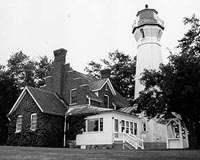History
Characterized by shallow water and sandbanks, the 75-mile (121 km) stretch of coastline between the Fort Gratiot Light and Pointe aux Barques Light is a hazard to navigation. Even after the establishment of the Sand Beach Harbor of Refuge Light in 1875, 30 miles (48 km) of coast line still remained completely unlit. [12]
Eighteen years after the first attempts to get congressional funding, [13] the station was established and first lit in 1886. [14] This Lake Huron lighthouse is 30 miles (48 km) north of the Fort Gratiot Lighthouse (Michigan's oldest) in Port Huron, Michigan.
The Port Sanilac Light's foundation consists of dressed stone and timber. The octagon-hourglass-shaped tower (near its top) is made of tiered and reverse stair-stepped brick. It is 14 feet (4.3 m) in diameter at its base, and tapers vertically to 9 feet (2.7 m) diameter below the gallery. Eschewing the usual corbels, a dozen courses of bricks create the gallery support, with four indentations for windows, creating a watch room for the four points of the compass. [12] The lighthouse was built at a cost of $20,000. [15] The placement and the unique shape were dictated by and created because of budgetary constraints (Congress appropriated only half the money requested). Designed by Eleventh District Engineer Captain Charles E. L. B. Davis, the design has been called "both unique and architecturally significant in its elegance." [12] The tower is white with a red roof. [1]
This "handsome" lighthouse shares its design with only one other, Ile Aux Galets, also known as Skilligallee Island Light, on Lake Michigan. [16]
The Port Sanilac Light tower is capped with a cast iron lantern room, [12] which still houses a fourth order Fresnel lens [14] manufactured by Barbier and Fenestre of Paris. The lens and its brass reflector on one segment (the reflector blocked the lens on the landward side) send the light out in a 300 degree arc across the lake. Its focal plane is 69 feet (21 m) shines a beam of light visible for up to 16 nautical miles (30 km; 18 mi) in all directions, thus closing most of the 30 miles (48 km)-gap mentioned above. The light sits atop high ground at the head of a small bay. [12] This is one of only 70 such Fresnel lenses that are still operational in the United States, sixteen of which are use on the Great Lakes of which eight are in Michigan. [17]
Port Sanilac Light Station — Lake St. is a registered site on the National Register of Historic Places, being added on August 19, 1984 as listed site #84001842. Name of Listing: PORT SANILAC LIGHT STATION (U.S. COAST GUARD/GREAT LAKES TR). [1]
The Port Sanilac Light complex currently consists of five historic structures. In addition to the light tower and ornate brick Lighthouse keeper's residence, [12] the brick oil house, [18] wooden outhouse, and well also survive. The well is covered by a safety platform of wooden planks. [15] [19]
Because of its unique and picturesque form and location, it is often the subject of photographs, and even of needlepoint illustrations. [20] Drawings have also been produced, [21] as have postcards. [1]
The original fourth order Fresnel lens is still operative, being one of only 70 such lenses that remain operational in the United States; sixteen of them are use on the Great Lakes, of which eight are in Michigan. [6]
The lighthouse, including the keeper's house, is for sale. [22] [23] [24] [25]
This page is based on this
Wikipedia article Text is available under the
CC BY-SA 4.0 license; additional terms may apply.
Images, videos and audio are available under their respective licenses.



